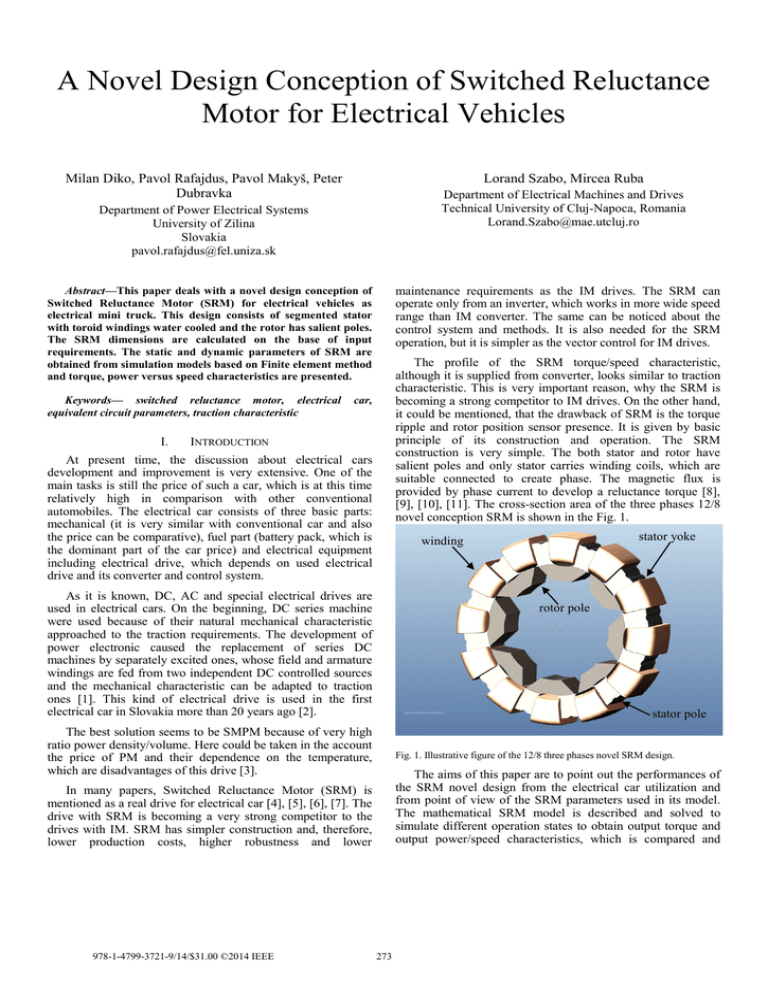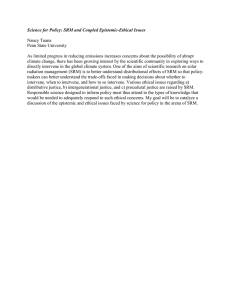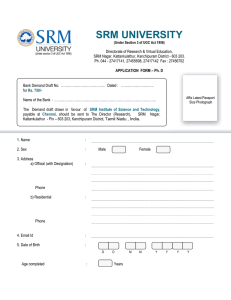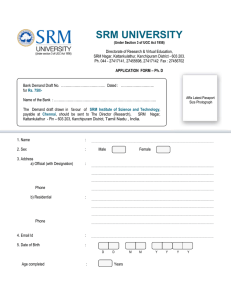Paper Title (use style: paper title)
advertisement

A Novel Design Conception of Switched Reluctance Motor for Electrical Vehicles Lorand Szabo, Mircea Ruba Milan Diko, Pavol Rafajdus, Pavol Makyš, Peter Dubravka Department of Electrical Machines and Drives Technical University of Cluj-Napoca, Romania Lorand.Szabo@mae.utcluj.ro Department of Power Electrical Systems University of Zilina Slovakia pavol.rafajdus@fel.uniza.sk maintenance requirements as the IM drives. The SRM can operate only from an inverter, which works in more wide speed range than IM converter. The same can be noticed about the control system and methods. It is also needed for the SRM operation, but it is simpler as the vector control for IM drives. Abstract—This paper deals with a novel design conception of Switched Reluctance Motor (SRM) for electrical vehicles as electrical mini truck. This design consists of segmented stator with toroid windings water cooled and the rotor has salient poles. The SRM dimensions are calculated on the base of input requirements. The static and dynamic parameters of SRM are obtained from simulation models based on Finite element method and torque, power versus speed characteristics are presented. Keywords— switched reluctance motor, electrical equivalent circuit parameters, traction characteristic I. The profile of the SRM torque/speed characteristic, although it is supplied from converter, looks similar to traction characteristic. This is very important reason, why the SRM is becoming a strong competitor to IM drives. On the other hand, it could be mentioned, that the drawback of SRM is the torque ripple and rotor position sensor presence. It is given by basic principle of its construction and operation. The SRM construction is very simple. The both stator and rotor have salient poles and only stator carries winding coils, which are suitable connected to create phase. The magnetic flux is provided by phase current to develop a reluctance torque [8], [9], [10], [11]. The cross-section area of the three phases 12/8 novel conception SRM is shown in the Fig. 1. car, INTRODUCTION At present time, the discussion about electrical cars development and improvement is very extensive. One of the main tasks is still the price of such a car, which is at this time relatively high in comparison with other conventional automobiles. The electrical car consists of three basic parts: mechanical (it is very similar with conventional car and also the price can be comparative), fuel part (battery pack, which is the dominant part of the car price) and electrical equipment including electrical drive, which depends on used electrical drive and its converter and control system. As it is known, DC, AC and special electrical drives are used in electrical cars. On the beginning, DC series machine were used because of their natural mechanical characteristic approached to the traction requirements. The development of power electronic caused the replacement of series DC machines by separately excited ones, whose field and armature windings are fed from two independent DC controlled sources and the mechanical characteristic can be adapted to traction ones [1]. This kind of electrical drive is used in the first electrical car in Slovakia more than 20 years ago [2]. rotor pole stator pole The best solution seems to be SMPM because of very high ratio power density/volume. Here could be taken in the account the price of PM and their dependence on the temperature, which are disadvantages of this drive [3]. Fig. 1. Illustrative figure of the 12/8 three phases novel SRM design. The aims of this paper are to point out the performances of the SRM novel design from the electrical car utilization and from point of view of the SRM parameters used in its model. The mathematical SRM model is described and solved to simulate different operation states to obtain output torque and output power/speed characteristics, which is compared and In many papers, Switched Reluctance Motor (SRM) is mentioned as a real drive for electrical car [4], [5], [6], [7]. The drive with SRM is becoming a very strong competitor to the drives with IM. SRM has simpler construction and, therefore, lower production costs, higher robustness and lower 978-1-4799-3721-9/14/$31.00 ©2014 IEEE stator yoke winding 273 discussed. The input parameters are: rated power 20 kW, rated speed 5000 rpm, DC voltage 300 V and maximal current is 250 A. V where ω is angular velocity and V is DC supply voltage. At rated speed ψpeak occurs well before the aligned position, typically when the overlap between the stator and rotor poles is about 2/3 of the stator pole arc. At this moment, it can be assumed that the ampere-turns are sufficient to bring the stator pole to the flux density Bs, then: On the base of this analysis and the suitability of the SRM for electrical car, a new real SRM prototype will be manufactured for a real electrical car to replace existing DC drive. II. peak DESIGN PROCEDURE A. SRM sizing dimensions Design procedure of SRM is made with the required outer geometric dimensions of the existed DC motor, mainly outer stator diameter ds and stack length lFe, which are chosen: ds = 300 mm and lFe = 100 mm, for voltage level of 300 V. The proposed number of phases is m = 3, because lower torque ripple is needed and motor can start up from every rotor position. The number of stator and rotor poles is given as Ns / Nr = 12/8. A novel concept of SRM consists of segmented stator with concentrated windings and shorted magnetic flux paths. peak SBs nc N p Where S is cross-section of magnetic flux path, nc is number of phase coils connected in serial and Np is number of one coil turns. Substituting of eq. (2) to (3), Np V SBs nc where nc is number of coils per phase. The flux density of stator pole can be supposed 1.6 T. The cross section of coil wires is depended on normalized wire conductor. The calculation is based on constant flux density (1.6 T). The basic geometrical parameters of the winding are in the Fig.3. B. Sizing internal dimensions The basic topology of geometry is shown in Fig. 2. The SRM dimensions are calculated on the base of known analytical equations used during common SRM design procedure. It is described in [3] and [11]. Fig. 3. The basic geometrical winding parameters of the SRM novel concept. D. Static parameters calculation On the base of this design the static characteristics as phase inductance, magnetic flux linkage and torque versus phase current and rotor position have been calculated by means of FEM. The analytical approach is used only for geometrical dimension calculations. The results are in the Fig. 4, Fig. 5 and Fig. 6, respectively. Fig. 2. Basic topology of 12/8 three phases SRM novel concept. C. Winding coil design The calculation of the number of turns Np can be made by assuming that at the specified speed the conduction angle of power transistors is equal to the stroke angle ε, which is defined as: 2 mN r where m is number of phases and Nr is number of rotor poles. If there is no current – chopping the peak flux linkage per phase is given by: 274 i di Te 0 The voltage equation of one SRM phase is given as: v Ri d dt where R is phase resistance, i is phase current and is flux linkage. The flux linkage depends on both parameters: phase current and rotor position ( = f (i, Θ)). Then Fig. 4. FEM analysis of inductance for various rotor position and current. d di d dt i dt dt The phase current is calculated from combination of (6) and (7) as: dL i, v R i d di dt L i, The real angular speed is calculated from equation: m d 1 T j (, i) Tload dt J j 1 where J is the moment of inertia and Tload is load torque. The SRM is controlled on the base of rotor position Θ, therefore it is as following: Fig. 5. FEM analysis of flux linkage for various rotor position and current. dt On the base of this mathematical model a simulation model has been created to solve transients for different speeds, loads, switch ON, switch OFF angles to find optimal dynamic operation of SRM. The simulation of currents, speed and torque waveform has been done for demanded speed 5000 rpm. In the Fig. 7 speed waveform is shown during startup to 5000 rpm and at t = 0.6 a 65 Nm load is connected. Fig. 6. FEM analysis of torque for various rotor position and current. E. Dynamic analysis of SRM By using mathematical model in the dynamic analysis we can calculate phase current, speed, voltage and dynamic torque of the SRM. The electromagnetic torque of SRM can be calculated from: 275 Fig. 7. Speed waveform with n = 5000 rpm. The current waveforms for all three phases, start up, load connection for speed 5000 rpm are shown in the Fig. 8. Fig. 10. Total torque ripple detail for n = 5000 rpm. On this base of all required parameters, the output characteristics torque and power versus speed have been obtained from dynamic simulation. These characteristics are shown in the Fig. 11 and Fig. 12 for current up to 250 A. Fig. 8. Phase currents for n = 5000 rpm. The total torque given by all three phase is shown in the Fig. 9 and the torque ripple detail is in the Fig. 10 respectively. Fig. 11. Total torque versus speed for working range of proposed novel SRM design Fig. 9. Total torque for n = 5000 rpm. Fig. 12. Output power versus speed for working range of proposed novel SRM design 276 III. The losses calculation can be carried out in accordance with [11] and [12]. As it is known, two dominant parts of losses are in electrical machines: winding losses and core losses. In this case both of them have been analyzed and calculated. To calculate the efficiency, the input power is needed. It could be given from known equation for instantaneous power. On this base, the efficiency of designed SRM for various speeds from 1000 to 5000 has been calculated. The results are from 89 % to 92 %, what are acceptable values for SRM. The working point of this motor is around 5000 rpm and 65 Nm what is 34 kW of output power. It can be noticed, that required input parameters were over obtained and an optimization process can be carried out to minimize some dimensions and losses. The basic masses of designed SRM are shown in the Table I. TABLE I. The paper deals with the SRM novel design and static and dynamic parameters investigation from point of view of its application and using in electrical cars. In the future, the optimization of this concept will be carried out to minimize materials and losses and to improve efficiency of this motor. On this base a prototype of SRM will be manufactured and used in the real car. ACKNOWLEDGMENT This work was supported by the Slovak Research and Development Agency under the Contract No. SK-RO-0028-12 and by Slovak Scientific Grant Agency VEGA No. 1/0940/13. This paper is supported also by the following project: University Science Park of the University of Zilina (ITMS: 26220220184) supported by the Research&Development Operational Program funded by the European Regional Development Fund. BASIC SRM MASSES 12/8 designed SRM Defined part of SRM kg CONCLUSION kg REFERENCES Winding mass 1.9 (Al) 5.75 (Cu) Stator mass 10.25 - [1] Rotor mass 4.845 - Total mass 17 (Al) [2] [3] 20.8 (Cu) [4] This SRM design described above has been calculated on the base of analytical calculation and FEM without its optimization. The prototype model of this novel SRM design with segmented stator is shown in the Fig. 13. [5] [6] [7] [8] [9] [10] [11] Fig. 13. The prototype model of this novel SRM design with segmented stator [12] In the next, the thermal analysis will be carried out with water cooling system and some recommendations will be given for manufacturing process. [13] 277 I. Boldea, "Control issues in adjustable speed drives", IEEE Industrial Electronics Magazine, vol. 2, no. 3 (September 2008), pp. 32-50.J. http://elektromobily.sk/ako-sa-rodil-prvy-slovensky-elektromobil Pyrhonen, T. Jokinen, V. Hrabovcová, "Design of Rotating Electrical Machines", Chichester (UK): John Wiley & Sons, 2008. T.J.E. Miller, "Electronic Control of Switched Reluctance Machines", Oxford (U.K.): Newnes, 2001. J. Gao, H. Sun, L. He, Y. Dong, Y. Zheng, "Optimization Design of Switched Reluctance Motor based on Particle Swarm Optimization," in Proceedings of the 2011 International Conference on Electrical Machines and Systems (ICEMS '2011), 2011, pp. 1-5. X.D. Xue, K.W.E. Cheng, T.W. Ng, N.C. Cheung, "Multi-Objective Optimization Design of In-Wheel Switched Reluctance Motors in Electric Vehicles" IEEE Transactions on Industrial Electronics, vol. 57, no. 9 (September 2010), pp. 2980-2987. K.M. Rahman, B. Fahimi, G. Suresh, A.V. Rajarathnam, M. Ehsani, "Advantages of switched reluctance motor applications to EV and HEV: design and control issues", IEEE Transactions on Industry Applications, vol. 36, no. 1 (January-February 2000), pp. 111-121. C. Kamalakannan, V. Kamaraj, S. Paramasivam, S. Paranjothi, "Switched reluctance machine in automotive applications – A technology status review," in Proceedings of the 1st International Conference on Electrical Energy Systems (ICEES '2011), Newport Beach (USA), 2011, pp. 187-197. M. Krishnamurthy, C.S. Edrington, A. Emadi, P. Asadi, M. Ehsani, B. Fahimi, "Making the case for applications of switched reluctance motor technology in automotive products", IEEE Transactions on Power Electronics, vol. 21, pp. 659-675, 2006. I. Nuca, P. Todos, V. Esanu, "Urban electric vehicles traction: Achievements and trends, " in Proceedings of the International Conference and Exposition on Electrical and Power Engineering (EPE '2012), Iaşi (Romania), pp. 76-81, 2012. R. Krishnan, "Switched Reluctance Motor Drives: Modeling, Simulation, Analysis, Design, and Applications," Boca Raton (USA): CRC Press, 2001. P. Rafajdus, V. Hrabovcova, P. Hudak, "Investigation of Losses and Efficiency in Switched Reluctance Motor", in Proceedings of the 12th International Power Electronics and Motion Control Conference (EPE-PEMC '2006), Portoroz (Slovenia), 2006. M. Takeno, A. Chiba, N. Hoshi, S. Ogasawara, M. Takemoto, M.A. Rahman: "Test Results and Torque Improvement of the 50-kW Switched Reluctance Motor Designed for Hybrid Electric Vehicles", IEEE Transactions on Industry Applications, vol. 48, no. 4 (July/August 2014). [14] B. Skala, J. Hrusak, D. Mayer, M. Stork, "On Strongly Nonlinear Phenomena in Electrical Machines", New aspect of systems," in Proccedings of the 2008 WSEAS International Conference. Mathematics and Computers in Science and Engineering (No. 12), Heraklion (Greece), pp. 120-125, 2008. [15] L. Szabó, M. Ruba, "Segmental stator switched reluctance machine for safety-critical applications", IEEE Transactions on Industry Applications, vol. 48, no. 6 (December 2012), pp. 2223-2229. [16] J. Kaňuch, Ž. Ferková, "Design and simulation of disk stepper motor with permanent magnets", Archives of Electrical Engineering, vol. 62, no. 2 (2013), pp. 281-288. 278


